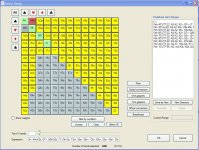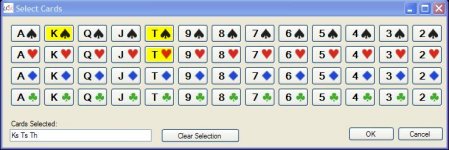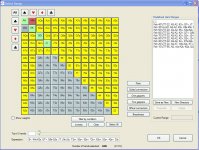Stu_Ungar
Legend
Silver Level
This follows on from a thread about post flop play.
What I would like to do is to follow on from what ChuckTs was doing about a year ago with poker razor.
https://www.cardschat.com/forum/cash-games-11/stox-co...alyses-133725/
https://www.cardschat.com/forum/cash-games-11/pokeraz...-loose-137844/
https://www.cardschat.com/forum/cash-game-hand-analysis-50/pokeraz...et-pot-136958/
I'd like to start by going back over what he did (as I think this will improve our own understanding) and then maybe take it a bit further.
To begin with I'd like this thread to be primarily concerned with c-betting and our villain's likely calling and or raising ranges to our c-bet.
I'd like to concentrate just on the flop to begin with because I think we should walk before we run.
As this thread is a poker razor thread.. you will need poker razor.
http://pokerazor.com/
Next of all I'd like to propose the rule, that whatever conclusions you draw must be demonstrated via poker stove. Otherwise it sort of defeats the purpose of the thread.
To begin with I would like to approach this in a scientific type of way.
So lets agree upon
1. Ranges for common types of villains. These will be our standard ranges, so lets all agree on them.
2. Common flops. These will be our standard flops. So if we are talking of say a 2 tone low flop then 8h 4h 2s, might be our standard 'low two tone flop'
Once we have agreed upon standard ranges for our villain types and a range of flops that give us a picture of how that villain performs on generic flops, then we can start plugging that info into poker razor and figuring out what it all means.
We can later digress from this, but to begin with I really do think the standardised villains and standard flops will really help.
Just remember the golden rule.. whatever you come up with must be demonstrated in Poker Razor.
Hopefully this should be an interesting project and one where we all improve our post flop play.
What I would like to do is to follow on from what ChuckTs was doing about a year ago with poker razor.
https://www.cardschat.com/forum/cash-games-11/stox-co...alyses-133725/
https://www.cardschat.com/forum/cash-games-11/pokeraz...-loose-137844/
https://www.cardschat.com/forum/cash-game-hand-analysis-50/pokeraz...et-pot-136958/
I'd like to start by going back over what he did (as I think this will improve our own understanding) and then maybe take it a bit further.
To begin with I'd like this thread to be primarily concerned with c-betting and our villain's likely calling and or raising ranges to our c-bet.
I'd like to concentrate just on the flop to begin with because I think we should walk before we run.
As this thread is a poker razor thread.. you will need poker razor.
http://pokerazor.com/
Next of all I'd like to propose the rule, that whatever conclusions you draw must be demonstrated via poker stove. Otherwise it sort of defeats the purpose of the thread.
To begin with I would like to approach this in a scientific type of way.
So lets agree upon
1. Ranges for common types of villains. These will be our standard ranges, so lets all agree on them.
2. Common flops. These will be our standard flops. So if we are talking of say a 2 tone low flop then 8h 4h 2s, might be our standard 'low two tone flop'
Once we have agreed upon standard ranges for our villain types and a range of flops that give us a picture of how that villain performs on generic flops, then we can start plugging that info into poker razor and figuring out what it all means.
We can later digress from this, but to begin with I really do think the standardised villains and standard flops will really help.
Just remember the golden rule.. whatever you come up with must be demonstrated in Poker Razor.
Hopefully this should be an interesting project and one where we all improve our post flop play.




